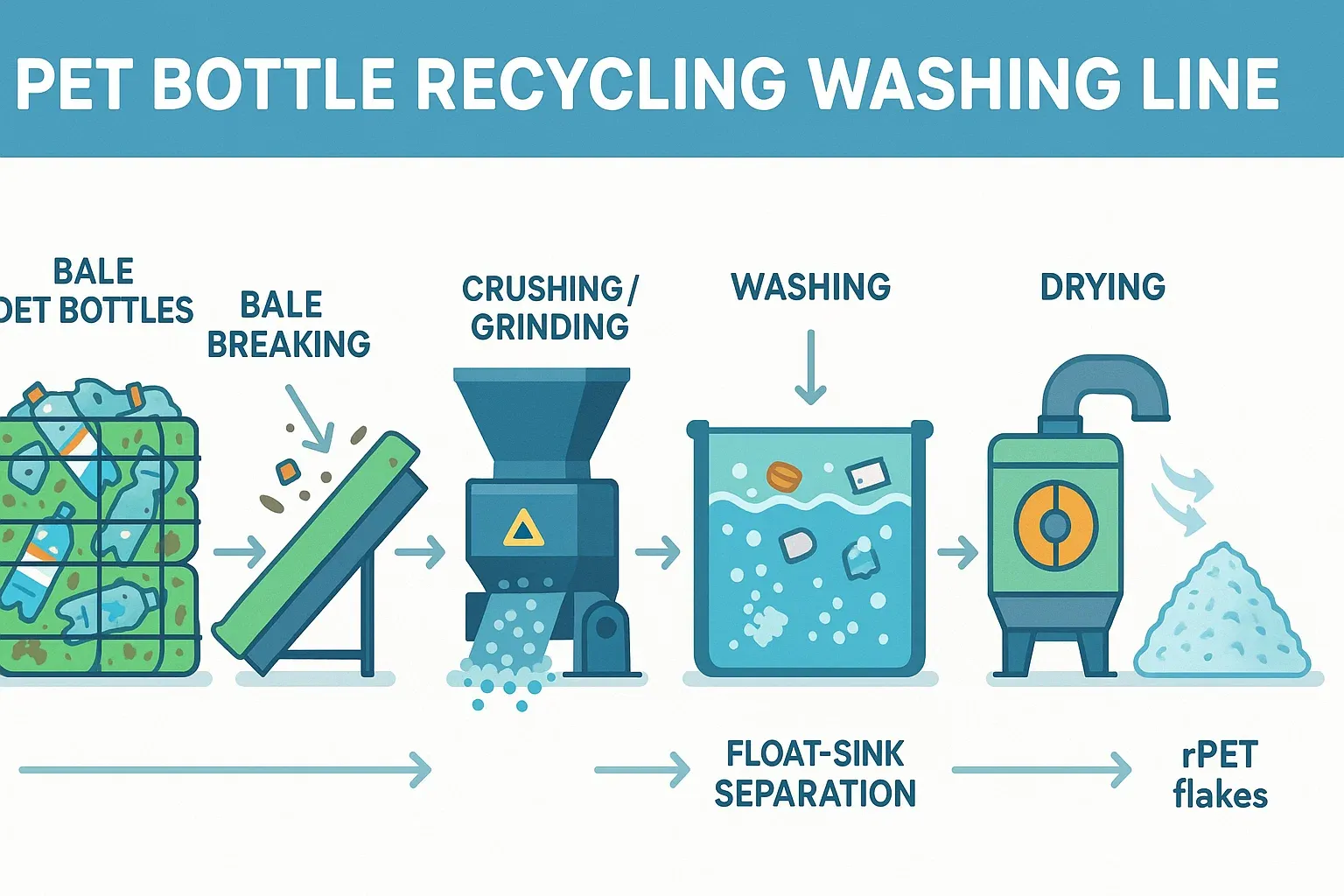What is a PET Bottle Recycling Washing Line?
In the world of plastics recycling, a PET bottle recycling washing line is a specialized system of equipment working together. Its main job is straightforward: to take bales of collected, used PET (polyethylene terephthalate) bottles – the kind typically used for drinks – and clean them thoroughly. The end goal is to produce high-quality, clean PET flakes that can be used as a raw material for new products.
Why is a Dedicated Washing Line Necessary?
Used PET bottles don’t arrive clean. When collected from consumers or businesses, they come mixed with various contaminants:
- Labels: Paper or plastic labels glued onto the bottles.
- Caps and Rings: Often made from different plastics like PP (polypropylene) or PE (polyethylene).
- Dirt and Grime: Soil, dust, and general muck from collection and storage.
- Leftover Liquids: Residue from beverages.
- Adhesives: Glue used for labels.
- Other Materials: Sometimes non-PET plastics or other debris get mixed in.
To create valuable, reusable PET flakes (often called rPET), all these contaminants must be effectively removed. If left in, they drastically lower the quality and usability of the recycled plastic, potentially making it unsuitable for many applications, especially food-grade packaging or high-quality fibers.
How a PET Bottle Washing Line Works: Key Stages and Features
While designs vary, most PET washing lines follow a similar multi-stage process, with each piece of equipment performing a specific task:
Incoming PET bottles usually arrive tightly compressed into large bales. A bale breaker machine opens these bales, separating the bottles so they can flow through the system individually.
Benefit: Ensures a steady, manageable flow of material into the line.
Sometimes done manually or using automated sorters (like optical sorters), this stage removes obvious non-PET items (like different plastic types, metal, or trash) early on.
Benefit: Protects downstream equipment and improves overall efficiency by removing unwanted materials upfront.
The whole bottles are fed into a crusher or granulator. This machine cuts the bottles into smaller, relatively uniform pieces, often called „flakes.“
Feature: Produces consistent flake size.
Benefit: Smaller flakes are much easier and more effective to wash and clean thoroughly compared to whole bottles.
Techniques like air classification (zig-zag separators) or specialized friction washers are used. Air currents or mechanical action help separate lighter materials like label fragments and fine dust from the heavier PET flakes.
Benefit: Removes a significant portion of paper and plastic film contamination.
This is the core cleaning process.
- Pre-washing/Rinsing: Often involves cold water to remove loose dirt and surface contaminants.
- Hot Washing: Flakes are washed in hot water, typically mixed with a caustic soda (sodium hydroxide) solution and detergents. This is a critical step.
Feature: Utilizes heat and chemical action.
Benefit: Effectively dissolves glues, removes grease and oils, sterilizes the flakes, and helps detach stubborn residue.
- Further Rinsing: Multiple stages of rinsing with clean water follow the hot wash.
Benefit: Removes any remaining detergent, caustic solution, and loosened contaminants.
This stage leverages material density. The washed mixture of flakes enters a large tank filled with water.
Feature: Utilizes the difference in specific gravity between PET and other plastics.
Benefit: PET flakes, being denser than water, sink to the bottom. Lighter plastics like PP and PE (from caps and rings) float to the top and are skimmed off. This is a crucial step for achieving high purity PET.
The clean PET flakes need to have their moisture content significantly reduced.
- Mechanical Drying: Often uses a centrifugal dryer (spin dryer) to remove the bulk of the water.
- Thermal Drying: Hot air systems further dry the flakes to meet specific moisture level requirements (often below 1%).
Benefit: Produces flakes suitable for storage and further processing (like extrusion or pelletizing) without issues caused by excess moisture.
Some advanced lines include final sorting steps, like electrostatic separators or additional optical sorters, to remove any remaining non-PET plastics or colored PET flakes if required. Dust removal systems ensure minimal fine particles remain.
Benefit: Achieves the highest possible purity levels, essential for demanding applications like bottle-to-bottle recycling.
Key Benefits and Qualities of Effective PET Washing Lines:
- High-Quality Output: The primary goal is producing clean, pure PET flakes with minimal contamination, ready for reuse. Consistency is key.
- Value Creation: Transforms low-value post-consumer waste into a valuable industrial feedstock (rPET).
- Environmental Impact: Supports the circular economy by enabling closed-loop recycling, reducing landfill burden, and lessening the need for virgin plastic production.
- Efficiency: Modern lines are designed for high throughput while aiming to minimize water and energy consumption.
- Reliability and Durability: Built for continuous industrial operation, minimizing downtime.
- Automation: Increased automation reduces labor costs and improves process consistency.
In Summary:
A PET bottle recycling washing line is not just one machine, but an integrated system designed to tackle the specific challenge of cleaning contaminated post-consumer bottles. By effectively removing labels, caps, dirt, glue, and other impurities through a series of mechanical and chemical processes, these lines produce clean, high-quality PET flakes. This output is a vital commodity for manufacturers seeking sustainable materials, making washing lines a cornerstone technology in the plastics recycling infrastructure and a critical enabler of the circular economy. Businesses investing in these systems look for efficiency, reliability, and the consistent ability to meet stringent quality standards for the final rPET product.

